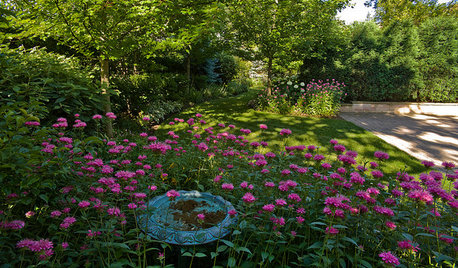lawn care program
new02organics
9 years ago
Related Stories

COMMUNITYWant a Cleaner, Safer Neighborhood? Show You Care
Our behavior strongly influences others, says a new study. Show neighbors you care about your street and watch them follow suit
Full Story
LANDSCAPE DESIGNExuberant Self-Seeders for Gorgeous, Easy-Care Gardens
Keep weeds down, color high and maintenance low with beautful plants that sow themselves
Full Story
GARDENING GUIDESTree Care: Common Tree Diseases and What to Do About Them
Learn to recognize trees that may be affected by diseases or pests so you can quickly take action
Full Story
LANDSCAPE DESIGNCalifornia Says Goodbye to the Sprawling Ornamental Lawn
New state rules will effectively limit turfgrass to 25 percent of the landscape in most new and renovated yards
Full Story
LANDSCAPE DESIGN15 Great Ideas for a Lawn-Free Yard
End the turf war for good with hardscaping, native grasses and ground covers that save water and are easier to maintain
Full Story
BEFORE AND AFTERSSee 6 Yards Transformed by Losing Their Lawns
Wondering whether a turf lawn is the best use of your outdoor space? These homeowners did, and they found creative alternatives
Full Story
EARTH DAYThe Case for Losing the Traditional Lawn
Work less, help the environment and foster connections by just saying no to typical turf
Full Story
FRONT YARD IDEASBefore and After: Front Lawn to Prairie Garden
How they did it: Homeowners create a plan, stick to it and keep the neighbors (and wildlife) in mind
Full Story
SAVING WATERHouzz Call: Are You Letting Go of Your Lawn?
Many facing a drought are swapping turf for less thirsty plantings. If you’re one of them, we’d like to hear about it
Full Story
GRASSESHow to Rock a Lawn
Weekend Project: The key to healthy grass begins with the soil. If turf works for you, here’s how to fix it and keep it looking its best
Full StoryMore Discussions







dchall_san_antonio
new02organicsOriginal Author
Related Professionals
Reading Landscape Architects & Landscape Designers · East Rancho Dominguez Landscape Architects & Landscape Designers · La Marque Landscape Architects & Landscape Designers · Lake Oswego Landscape Architects & Landscape Designers · Suffern Landscape Architects & Landscape Designers · Vernon Hills Landscape Architects & Landscape Designers · Walnut Landscape Architects & Landscape Designers · Cupertino Landscape Contractors · Fort Hunt Landscape Contractors · Melrose Landscape Contractors · Quincy Landscape Contractors · Rockville Landscape Contractors · Weslaco Landscape Contractors · Golden Valley Landscape Contractors · Stafford Swimming Pool Buildersdchall_san_antonio